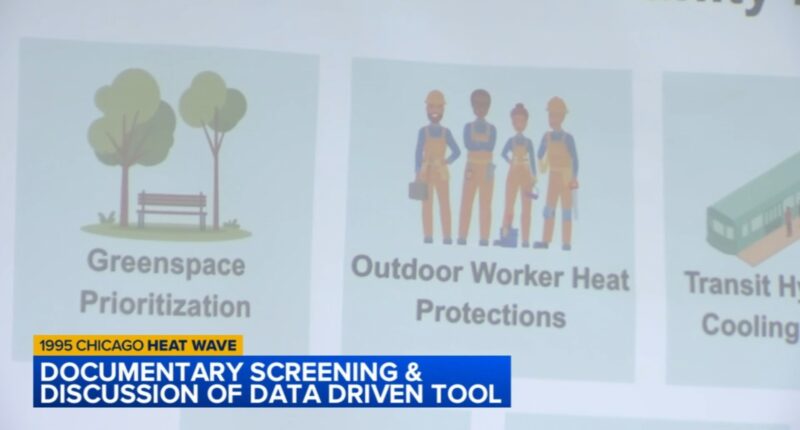CHICAGO (WLS) — It was 30 years ago this week that the deadly heat wave of 1995 hit Chicago.
And on Tuesday, the city detailed a new tool part of a larger project to pinpoint areas most vulnerable or at-risk to extreme heat and translate that into a plan with a life-saving purpose.
ABC7 Chicago is now streaming 24/7. Click here to watch
The images showcased in a West Side documentary screening about the deadly heat wave struck a personal chord among the crowd. People there either lived through it or are working to make sure no has to live through it again.
“We have to do what we can, learn from the mistakes of the past in order to save lives, because all heat deaths are preventable,” said Dr. Sheetal Rao with Diffusing Disasters.
In a special screening of “Cooked: Survival by Zip Code,” attendees were taken back to a dark period of Chicago’s history and the lessons carried through deep loss.
“Many of those lives that were lost were Black, elderly, low-income residents,” said Chicago Mayor Brandon Johnson. “It became abundantly clear that environmental crises never just about the weather. In fact, they are more about equity and access.”
SEE ALSO | 30 years later: How deadly 1995 heat wave exposed deep flaws in Chicago’s emergency systems
City leaders at Tuesday night’s screen highlighted a new tool, called a Heat Vulnerability Index, or HVI.
It is a project by organization Diffusing Disasters, combining data and community engagement from those who survived the deadly heat wave.
“It’s a tool that looks at different socioeconomic and health and climate factors and puts them all together to come up with who is at most risk from extreme heat,” Rao said.
The new tool aims to help provide more thoughtful approaches to planning in times of disaster, using not just numbers, but testimony from those in the hardest impacted areas of that deadly summer.
“This HVI is more than a data tool. It allows us to see the differences throughout the city and visualize where disparities exist, and with those insights we can take action,” Johnson said.
The new tool provides a more community-informed approach to policy, designed to provide equitable planning with the hope those most underserved are not over looked.
The deadly heat wave changed how the city responds to emergencies.
READ MORE | 30 years later: Organizers remember 1995 heat wave victims, advocate for vulnerable Chicagoans
ABC7 also took a closer look at how the tragedy led to the development of the city’s Office of Emergency Management and Communications, and why it remains critical today.
The heat wave of 1995 is considered one of the deadliest weather events in this country. The OEMC was not in existence until several months later. But officials here have learned a great deal.
In July 1995, the sun and warm temperatures turned into blistering heat.
ABC7 took a closer look at how deadly 1995 heat wave in Chicago led to the development of the OEMC, and why it remains critical today.
“It’s almost like it caught everyone off guard about two days in. When the 911 calls started spiking and we started seeing those large scale fatality numbers,” said Kaila Lariviere with the OEMC.
While many healthy young people found reprieve on the lakefront, many vulnerable people, including the elderly population, were suffering in silence, because they did not have access to air conditioning.
“It really seems like everyone was just kind of excited for the heat, and then before they knew it, it was really bad,” Lariviere said.
Triple-digit temperatures for several days in a row became a crisis for Chicagoans confined to their homes. And as the casualties mounted, it overwhelmed the city’s services. They had to bring in trucks to store the bodies at the Cook County Medical Examiner’s Office.
“What we learned following the ’95 heat wave is there’s things we could’ve done better as a city coming together,” Lariviere said.
RELATED | 30 years later: How deadly 1995 heat wave led to formation of Chicago’s OEMC
These days, the OEMC is where everyone comes together. The office coordinates with the city, county, state, and other agencies, like ComEd.
“We’re shoulder-to-shoulder with the city to understand, what are their priorities with outages,” said ComEd Vice President Nichole Owens.
Each organization can coordinate a measured response while looking at what’s going in real time from 35,000-plus cameras in the city.
“Well, we, certainly now, we have caravans that we use. That’s another learning from the incident, where sometimes we have to take resources such as water, such as ice, to different locations,” Owens said.
Since 1995, many more changes have been implemented to mitigate the number of heat-related deaths:
- There is a coordinated “Wellness Check” system for the city’s most vulnerable, collaborating with churches and non-profits to do door knocks.
- City 311 Services were enhanced.
- Cooling centers are open across the city and suburbs during extreme heat.
- The city is “greener” with more trees and green roofs to combat urban heat.
- A citywide heat emergency plan was established that includes issuing public alerts.
“I’m not going to let 1995, the 1995 heat wave happen again on my watch, at least the outcomes of it,” Lariviere said.
Of course, it is impossible to know, but officials believe if the OEMC had existed in its current form back in 1995, most if not all of the 739 lives lost could have been saved.
The OEMC was not fully operational until months after the deadly heat wave.
Now, 911, 311, and emergency management are all under one roof, coordinating the city’s response to everything from severe weather to large-scale public events like Lollapalooza and parades.
Copyright © 2025 WLS-TV. All Rights Reserved.







